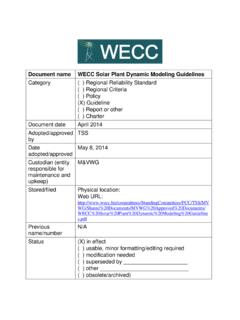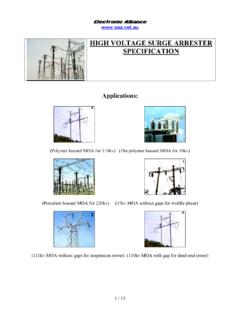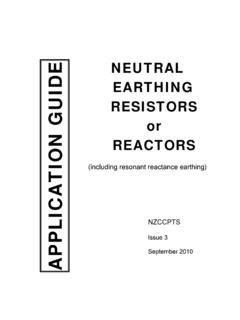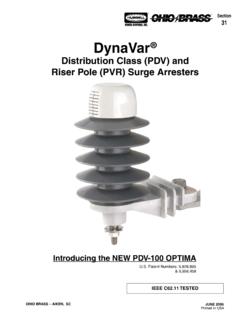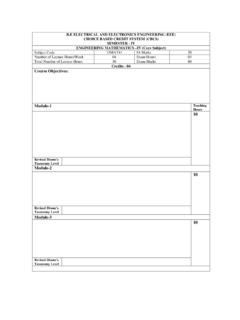Transcription of WECC Guideline: Guidelines for the Design of Critical ...
1 Document name Guidelines for the Design of Critical Communications Circuits Category ( ) Regional reliability Standard ( ) Regional Criteria ( ) Policy (x) Guideline ( ) Report or other ( ) Charter Document date November 18, 2010 Adopted/approved by WECC Telecommunications Work Group Date adopted/approved November 18, 2010 Custodian (entity responsible for maintenance and upkeep) WECC Telecommunications Work Group Stored/filed Physical location: Web URL: Previous name/number (if any) Status (x) in effect ( ) usable, minor formatting/editing required ( ) modification needed ( ) superseded by _____ ( ) other _____ ( ) obsolete/archived) 2 WECC Guideline: Guidelines for the Design of Critical Communications Circuits Date: 11/18/10 Table of Contents 1 PURPOSE.
2 4 2 SCOPE .. 4 3 4 4 ABBREVIATIONS AND ACRONYMS .. 4 5 FACILITIES .. 7 GENERAL .. 7 BUILDING STRUCTURES .. 7 TOWERS .. 7 ELECTRICAL & GROUNDING .. 7 Ground Potential Rise and 7 Building Electrical and Power Systems .. 7 POWER .. 7 Equipment Power .. 7 Communications Batteries .. 8 Battery Sizing .. 8 Battery Recharge .. 8 Monitoring .. 8 Generators .. 9 SECURITY & MONITORING .. 9 6 COMMUNICATIONS CABLES .. 9 GENERAL .. 9 METALLIC CABLES .. 9 Electrical Substations .. 9 Communications Facilities .. 11 FIBER-OPTIC CABLES.
3 11 Outside Plant .. 11 Inside Plant .. 12 PHYSICAL DIVERSITY .. 12 7 TRANSPORT Design .. 12 GENERAL .. 12 Equipment .. 12 MULTIPLEX SYSTEMS .. 12 Frequency Division .. 12 Time Division .. 12 Packet .. 12 3 MICROWAVE SYSTEMS .. 13 Licensed, Unlicensed, and Registered .. 13 Path Engineering .. 13 FIBER-OPTIC SYSTEMS .. 13 Optical Budget Engineering .. 13 POWER-LINE CARRIER SYSTEMS .. 13 Coordination .. 13 System Engineering .. 14 TELCO LEASED LINES FOR TRANSPORT .. 14 SATELLITE SYSTEMS .. 14 MONITORING .. 14 8 circuit Design , TESTING, AND MONITORING.
4 14 GENERAL .. 14 ANALOG CIRCUITS .. 14 Balanced Pairs .. 14 Analog Signal via Analog Microwave 14 Analog circuit Testing Standards .. 15 Analog Circuits Over Digital Systems .. 15 DIGITAL CIRCUITS .. 15 Compatibility Considerations .. 15 Testing Standards .. 16 Error Types and Analysis .. 16 Monitoring .. 16 9 Critical circuit AVAILABILITY CALCULATION METHODOLOGY .. 17 INTRODUCTION .. 17 reliability TERMS AND OTHER ACRONYMS .. 17 METHODOLOGY .. 18 AVAILABILITY INPUT PARAMETERS .. 20 AVAILABILITY CALCULATIONS .. 21 REFERENCES.
5 27 4 1 Purpose The purpose of these Guidelines is to provide communications system designers with the basic Design requirements for communications circuits that carry protective relaying, Remedial Action Scheme (RAS), or other Critical communications traffic. These Guidelines also include the Design of communication facilities that will ensure the performance of communication circuits. Finally, these Guidelines may be used as a resource of collective knowledge and to clarify specific requirements set forth by the Communications System Performance Guide for Protective Relaying Applications document.
6 2 Scope Communications circuits that are used for Critical traffic must perform during all kinds of power system operations and weather conditions. This document addresses the Design considerations and requirements for circuits that are used for these or similar purposes, as well as a variety of other types of circuits. Furthermore, this document can be used to interpret what can be done to bring communications circuits into compliance with the policies set forth by the Western Electricity Coordinating Council (WECC). 3 Overview It is crucial that Critical communications circuits perform as required.
7 Since most communications equipment is not hardened, as is other equipment used in the substation, it is more susceptible to noise. Therefore, special precautions must be taken when designing, installing, and operating this equipment. The Communications System Performance Guide for Protective Relaying Applications document sets forth requirements of performance for three classes of communications circuits. For clarification of availability requirements of the three classes of circuits, refer to Table 2 of that document. Please see Section 9 of this document for Critical circuit availability calculation methodology.
8 Recommendations on what to consider when designing circuits used for Critical communications follow. Please note that all standards and recommendations referred to in these Guidelines shall be the latest version in effect at time of Design . Existing systems designed to previous versions of referenced standards and recommendations shall not be required to conform to the latest version. 4 Abbreviations and Acronyms A Availability AC Alternating Current ADM Add/Drop Multiplex ADSS All-Dielectric Self Supporting 5 ANSI American National Standards Institute ATM Asynchronous Transfer Mode BER Bit Error Rate BICSI Building Industry Consulting Service International BIL Basic Impulse insulation Level CB Channel Bank CSU/DSU Channel Service Unit / Data Service Unit DC Direct Current DCS Digital Cross-connect System DS-0 Digital Signal level 0 DS-1 Digital Signal level 1 EB Errored Blocks EDFA Erbium Doped Fiber Amplifier EIA/TIA Electronic
9 Industries Alliance / Telecommunications Industry Association EM Errored Minutes ES Errored Seconds ESD ElectroStatic Discharge ESR Errored Seconds Ratio FIT Failures In Time GPR Ground Potential Rise IEC International Electrotechnical Commission IEEE Institute of Electrical and Electronics Engineers IP Internet Protocol ITU International Telecommunication Union KBPS KiloBits Per Second KV KiloVolt LOF Loss Of Frame LOS Loss Of Signal MOV Metal Oxide Varistor MPLS MultiProtocol Label Switching MTBF Mean Time Before Failure, also Mean Time Between Failure MTR Mean Time to Restore MTTR Mean Time To Repair 6 MW MicroWave NEBS Network Equipment Building System NECA National Electrical Contractors Association NESC National Electric Safety Code NMS Network Management System OC-3 Optical Carrier level 3 OOF Out Of Frame OPGW OPtical Ground Wire PPE Personal Protective Equipment QOS Quality Of Service RAS Remedial Action Scheme RFI Radio Frequency Interference RF Radio Frequency RMS Root Mean Square SD Space Diversity SES Severely Errored Seconds SESR Severely Errored Seconds Ratio
10 SONET Synchronous Optical NETwork STP Shielded Twisted Pair SWC Surge Withstand Capability Telco Telephone Company TT Transfer Trip U Unavailability UTC Utilities Telecom Council UTP Unshielded Twisted Pair VF Voice Frequency Virtual Tributary level WECC Western Electric Coordinating Council Failure rate per hour Restore rate per hour 7 5 Facilities General Due to the vital nature of protection circuits, all telecommunications facilities supporting Critical communications circuits shall be designed and maintained to WECC Criterions, NERC Standards, and other industry standards listed in this document.




